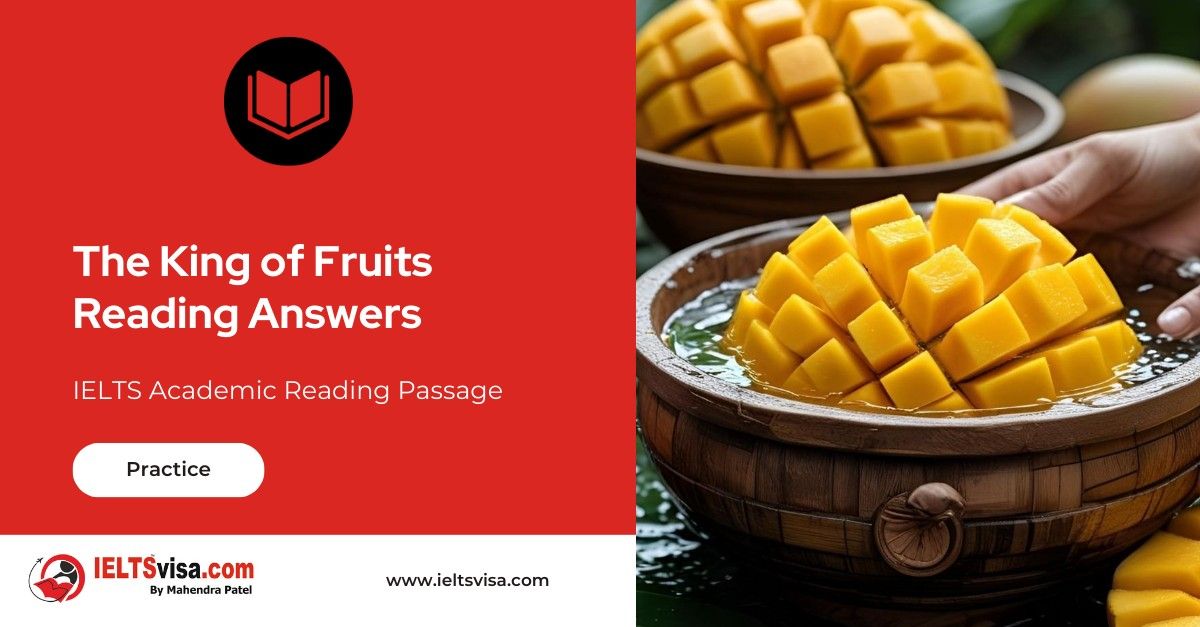The King of Fruits Reading Answers
IELTS Academic Reading Passage
A. One fact is certain: you’ll smell it before you see it. The scent (or should that be odor?) is overpowering (or should that be nauseating?). One inhales it with delight, or shrinks back in disgust. Is it sweet almonds with vanilla custard and a splash of whiskey? Or old socks garnished with rotten onion and a sprinkling of turpentine? Whatever the description, it wafts from what must be considered the most singular fruit on the planet—the durian, a Southeast Asian favorite, commonly called the ‘king of fruits’.
B. Its title is, in many ways, deserved. As fruits go, it is huge and imposing. As big as a basketball, up to three kilograms heavy, and most noticeably, covered with a thick and tough thorn-covered husk, it demands a royal respect. The thorns are so sharp that even holding the massive object is difficult. In supermarkets, they are usually put into mesh bags to ease handling, while extracting the flesh itself requires the wearing of thick protective gloves, a delicate and dextrous use of a large knife, and visible effort. One can see why it is increasingly popular, in western markets, to have that flesh removed, wrapped up, and purchased directly.
C. This leads one to wonder why nature designed such a smelly fruit in such an inconvenient package. Nature is, however, cleverer than one might think. For a start, that pungent odor allows easier detection by animals in the thick tropical forests of Brunei, Indonesia, and Malaysia, where the wild durian originates. When the pod falls, and the husk begins to crack open, wild deer, pigs, orangutans, and elephants are easily drawn forth, navigating from hundreds of meters away directly to the tree. The second clever fact is that, since the inner seeds are rather large, the durian tree needs correspondingly larger animals to eat, ingest, and transport these seeds away, hence the use of that tough spiny cover. Only the largest and strongest animals can get past that.
D. And what are they seeking? Upon prising open the large pod, one is presented with white fibrous pith in which are nestled pockets of soft yellowish flesh, divided into lobes. Each lobe holds a large brown seed within. Although these seeds themselves can be cooked and eaten, it is the surrounding flesh over which all the fuss is made. One of the best descriptions comes from the British naturalist, Alfred Wallace. Written in 1856, his experience is typical of many, and certainly of mine. At first, he struggled hard to overcome the ‘disagreeable aroma’, but upon ‘eating it out of doors’ found the flesh to have a ‘rich glutinous smoothness, neither acid nor sweet nor juicy; yet it wants neither of these qualities, for it is in itself perfect’. He ‘at once became a confirmed durian eater’. Exactly!
E. In actual fact, the flavor can vary considerably depending on the stage of ripeness and methods of storage. In Southern Thailand, the people prefer younger durians, with firmer texture and milder flavor, whereas in Malaysia, the preference is to allow the durian to fall naturally from the tree, then further ripen during transport. This results in a buttery texture and highly individual aroma, often slightly fermented. Whatever the case, it is this soft creamy consistency which easily allows durian to blend with other Southeast Asian delicacies, from candy and cakes, to modern milkshakes and ice cream. It can also appear in meals, mixed with vegetables or chili, and lower-grade durian (otherwise unfit for human consumption) is fermented into paste, used in a variety of local rice dishes.
F. Such popularity has seen the widespread cultivation of durian, although the tree will only respond to tropical climates’—for example, only in the very northern parts of Australia, where it was introduced in the early 1960s. Since that time, modern breeding and cultivation techniques have resulted in the introduction of hundreds of cultivars (subspecies bred, and maintained by propagation, for desirable characteristics). They produce different degrees of odor, seed size, color, and texture of flesh. The tree itself is always very large, up to 50 meters, and given that the heavy thorny pods can hang from even the highest branches, and will drop when ripened, one does not walk within a durian plantation without a hardhat—or at least, not without risking serious injury.
G. Thailand, where durian remains very popular, now exports most of this fruit, with five cultivars in large-scale commercial production. The market is principally other Asian nations, although interest is growing in the West as Asian immigrants take their tastes and eating preferences with them — for example, in Canada and Australia. The fruit is seasonal, and local, sale of durian pods is usually done by weight. These can fetch high prices, particularly in the more affluent Asian countries, and especially when one considers that less than one third of that heavy pod contains the edible pulp. In the true spirit of Alfred Wallace, there are certainly a large and growing number of ‘confirmed durian eaters’ out there.
Questions 1-4:
Reading Passage has seven paragraphs, A-G.
Write the correct letter, A-G, next to the questions.
Which paragraph gives a reason for durian’s
- spread outside of Asia?
- varieties of forms?
- variety of food uses?
- defining characteristics?
Questions 5-7:
Label the diagram.
Choose ONE WORD from the passage for each answer.

Question 5: ………………….
Question 6: ………………….
Question 7: ………………….
Questions 8-10
Do the following statements agree with the information given in Reading Passage One?
TRUE if the statement agrees with the information
FALSE if the statement contradicts the information
NOT GIVEN If there is no information on this
- The seeds can be eaten.
- Durian trees are grown in many parts of Australia.
- Thailand consumes the most durians.
Questions 11-13
Answer the questions. Choose NO MORE THAN TWO WORDS from the passage for each answer.
- What can help to carry durians around?
- Which sort of durian is usually fermented into paste?
- What should one wear when walking among durian trees?

Solution For: The King of Fruits Reading Answers
Reading Answers
| 1 G | 2 F |
| 3 E | 4 C |
| 5 thorns | 6 pith |
| 7 pocket(s) | 8 TRUE |
| 9 FALSE | 10 NOT GIVEN |
| 11 mesh bag(s) | 12 lower(-)grade durian |
| 13 (a) hardhat(s) |
Review and Practice
- Regularly practice with IELTS reading samples and time yourself to get used to the pressure of the exam.
- Review your mistakes to understand where you went wrong and how to avoid similar errors in the future.
Our Books
Master IELTS Speaking Part 1
IELTS Writing Task 1 Book
IELTS Writing Task 2 Book
The King of Fruits Reading Answers Explanation
Comin Soon
Practice IELTS Other Modules
IELTS Listening
The IELTS Listening test assesses how well you can understand spoken English in various contexts. It lasts about 30 minutes and is divided into four sections with a total of 40 questions. The listening tasks become increasingly difficult as the test progresses.
IELTS Academic Reading
The IELTS Academic Reading section assesses your ability to understand and interpret a variety of texts in academic settings. It is designed to evaluate a range of reading skills, including skimming for gist, reading for main ideas, reading for detail, understanding inferences, and recognizing a writer's opinions and arguments.
IELTS Speaking
The IELTS Speaking test assesses your ability to communicate in English on everyday topics. It lasts 11-14 minutes and consists of three parts: introduction, cue card, and a discussion based on the cue card topic.
IELTS General Reading
IELTS General Reading tests your ability to understand and interpret various types of texts. Here are some key areas and types of content you can expect to encounter in the reading section, along with tips for effective preparation.
IELTS Academic Writing Task 1
In IELTS Academic Writing Task 1, you are presented with a visual representation of information, such as graphs, charts, tables, or diagrams, and you are required to summarize, compare, or explain the data in your own words.
IELTS General Writing Task 1
In IELTS General Writing Task 1, you are required to write a letter based on a given situation. The letter can be formal, semi-formal, or informal, depending on the prompt. Here’s a breakdown of the key components to include in your letter
IELTS Academic Writing Task 2
In IELTS Academic Writing Task 2, you are required to write an essay in response to a question or topic. Here’s a guide to help you understand the essential elements of this task
IELTS Exam Tips
To succeed in the IELTS exam, practice regularly, familiarize yourself with the test format, improve your vocabulary, develop time management skills, and take mock tests to build confidence.
Grammer for IELTS
Grammar is the foundation of effective communication in English. Understanding tense usage, subject-verb agreement, and sentence structure enhances clarity and coherence in writing and speaking.
Vocabulary for IELTS
Vocabulary plays a crucial role in the IELTS (International English Language Testing System) exam, especially in the Speaking and Writing sections. Here’s an overview of why vocabulary is important and how it impacts your performance
RECENT IELTS SAMPLES QUESTIONS AND ANSWERS
Walking with dinosaurs
Peter L. Falkingham and his colleagues at Manchester University are developing techniques that...
Money as the Unit of Amount Reading Answers
The most difficult aspect of money to understand is its function as a unit of account. In...
WEATHERING IN THE DESERT
In the deserts, as elsewhere, rocks at the earth's surface are changed by weathering, which...
Nature on Display in American Zoos
The first zoo in the United States opened in Philadelphia in 1874, followed by the Cincinnati...
Can We Prevent the Poles From Melting
Such is our dependence on fossil fuels, and such is the volume of carbon dioxide we have...
Air conditioning the earth reading answers
The circulation of air in the atmosphere is activated by convection, the transference of heat...













